
by Alexander Glass and Orrin Pilkey Tuesday, April 9, 2013
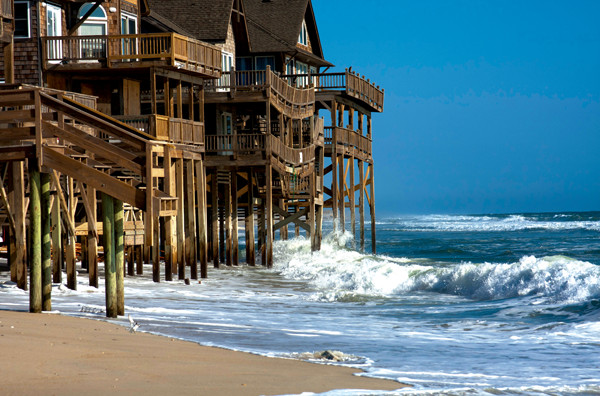
Beachfront homes in Rodanthe that will soon fall into the ocean. This row of homes used to include one made famous in the movie "Nights in Rodanthe," but that house was moved to a safer location. Tim Burkitt, FEMA
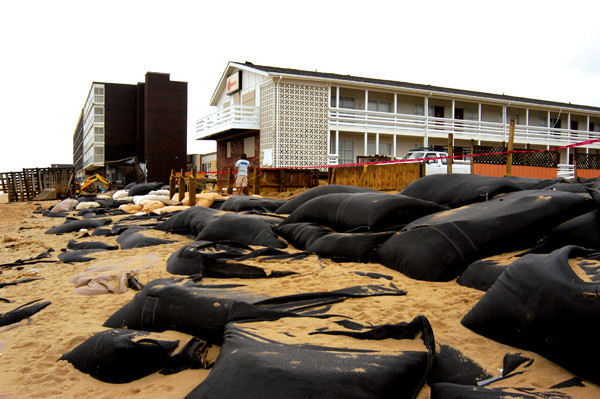
The Outer Banks are barrier islands. Such islands can migrate in a landward direction as sea levels rise. The post-storm shoreline retreat (erosion) seen here in Nags Head is part of that migration process. In North Carolina, large sandbags are used as seawalls to prevent shoreline retreat, but are damaging to the recreational value of the beach, provide only temporary protection and must constantly be maintained. Marilee Caliendo, FEMA
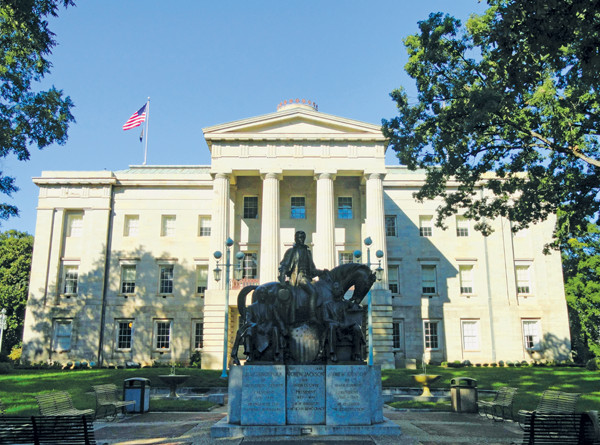
The North Carolina capitol building in Raleigh. At one point, the state legislature had a bill before it that effectively would have made sea-level rise illegal. Daderot
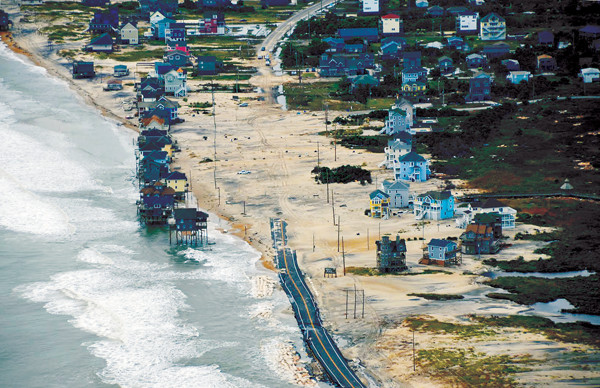
Anticipated sea-level rise aside, North Carolina already has a long and continuous history of battling shoreline erosion. Highway 12 (left and above) is perhaps the most rebuilt section of roadway in North America, as it is frequently washed out by storms. Andy Coburn, Program for the Study of Developed Shorelines
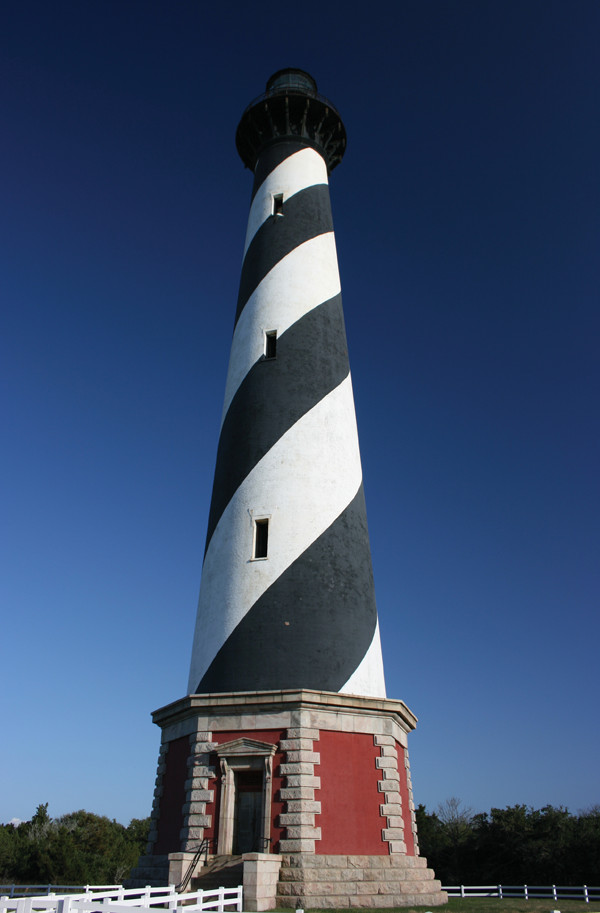
The 3,084-metric-ton Cape Hatteras lighthouse was moved 610 meters back from the shoreline by the National Park Service in 1999. A National Academy of Sciences panel found that the sea would have otherwise claimed this historical structure. North Carolina Department of Transportation
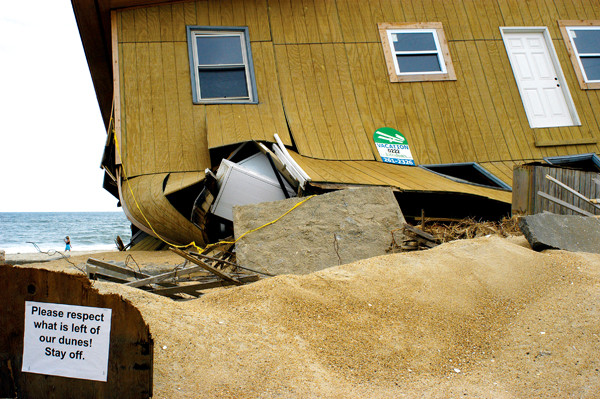
A damaged beachfront home in Kitty Hawk.
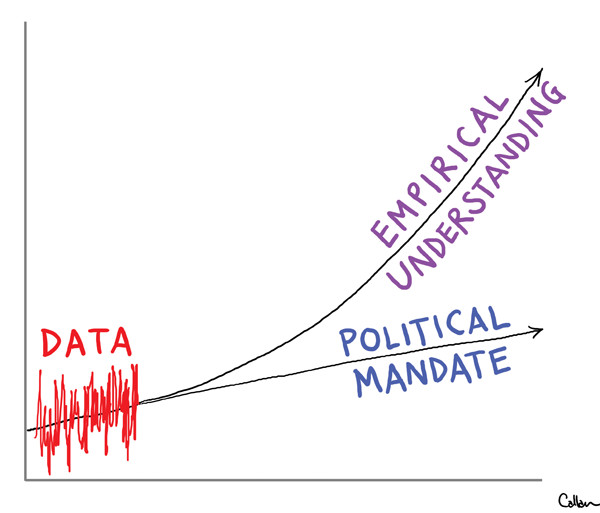
Science, politics and economics collided in North Carolina over sea-level rise. Copyright Callan Bentley, 2013
On the surface, it looks like America is a place where scientists and scientific achievements are held in high regard. The retired space shuttles were welcomed by flag-waving crowds; millions of people watched Curiosity’s nail-biting landing on Mars and James Cameron’s descent into the Mariana Trench. The discovery of the Higgs boson made front-page headlines and captured the imaginations of a nation. It would seem that America still loves and respects science.
However, just below the surface, there is another America. This America is populated by people who — on economic, political or religious grounds — have chosen to reject the consensus of the global scientific community on various topics. They enjoy the innovative gadgets and technological comforts afforded to us by scientific discoveries, but choose to treat science as a shopping trip to the supermarket, picking some conclusions to accept and others to reject at will. These “merchants of doubt” arbitrarily and inconsistently divide the sciences into “good” and “junk” science depending on their philosophical needs, and work diligently to portray high levels of uncertainty in scientific explanations where little actually exists.
In just the first month and a half of 2013, eight different anti-science bills were introduced in five states. Under the guise of “academic freedom,” these bills would allow or require public school teachers to “critically review” allegedly scientifically controversial explanations, including evolution and global warming. Neither of these theories is controversial within the scientific community. Alas, they are controversial among much of the American public.
A June 2012 Gallup poll showed that 46 percent of Americans deny the reality of human evolution and a mere 39 percent accept evolution in general. According to a January 2013 poll done by Duke University’s Sanford School of Public Policy, 84 percent of Americans believe that climate change is either definitely or probably real; however, just 64 percent acknowledge that humans are the underlying cause of rapid recent change. Americans might claim to be supporters of science, but many clearly cling to ideas that are at odds with the best scientific evidence.
Now we can add sea-level rise to the growing list of “controversial” topics. Last year, in North Carolina, the legislature introduced a bill that would have required state agencies to estimate future sea-level rise based only on linear projections of historic sea-level rise, rather than on models and field observations that show the rate can change over time. The legislative response to sea-level rise projections in North Carolina became a highly visible example of the shopping-at-the-supermarket view of science. Subsequent events led to the complete dismissal of scientific input by the state government and the passage of non-science-based sea-level rise legislation, delaying any consideration of sea-level rise for planning purposes in the foreseeable future. By summarizing the events and strategies used by the anti-science proponents in North Carolina, we hope to provide a warning to other states and information for good-science advocates who will likely encounter similar local political opposition to sound climate science in the future.
In 2009, the North Carolina Coastal Resources Commission (CRC), a body that controls and regulates coastal development in North Carolina, tasked the 13 members of its advisory Science Panel to “prepare a report, based on a review of the published literature, of the known state of sea-level rise for North Carolina.” The report was also to include a summary of the latest projections of sea level through 2100.
Based on the latest scientific studies done both locally and globally, the Science Panel found that by 2100 a 40-centimeter sea-level rise is certain, 100 centimeters is likely, and 140 centimeters is possible. Not surprisingly, these sea-level rise estimates were consistent with those found by science panels in other states.
The assessment, published in March 2010, stated: “The Science Panel is confident that the [sea-level rise versus time] curves presented constrain the plausible range of sea level by 2100 as accurately as is possible at this time.” The Science Panel did not advocate for any particular response or policy to be enacted. However, they recommended that a 100-centimeter sea-level rise should be adopted as the basis for any future coastal management plan.
The report ignited a firestorm of controversy.
The opposition charge was led by the NC-20, a private group of business and local government individuals from each of the 20 coastal counties in the state. Originally formed to fight proposed insurance rate increases, they quickly adopted the sea-level rise report as their main target. The NC-20 correctly perceived that if regulations for development were based on a 100-centimeter sea-level rise, the cost to developers and homeowners would be enormous.
Fearing that the CRC was about to make the 100-centimeter projection a guideline for future development and long-term policymaking, the NC-20 sprang into action by meeting with members of the CRC and state legislators. Through a flurry of activities ranging from staging public presentations by known climate change deniers, lobbying state and county legislators, and releasing misleading statements to the media, the NC-20 was able to successfully coerce the CRC into rejecting the 100-centimeter projection. At the time, the only good news was that the CRC did not repudiate the entire science report, as the NC-20 had urged. However, this initial struggle over the Science Panel’s report would prove to be only the tip of the iceberg.
An immediate result of the NC-20-created controversy was the halting of the production, by the North Carolina Office of Emergency Management, of federally funded maps of projected coastal storm-surge inundation, assuming higher sea levels in the future. This is alarming because northeastern North Carolina has been recognized by NOAA as one of the three regions in the U.S. that are most susceptible to sea-level rise. North Carolina has coastal plains that slope so gently that a 30-centimeter rise in sea level could push the shoreline back three to six kilometers, rendering it particularly vulnerable to future storm surges. The other two regions with extreme risk from sea-level rise are the Mississippi Delta and South Florida.
In April 2011, State Representative and real estate broker Pat McElraft and others filed House Bill 819 with the North Carolina legislature. Although initially concerned only with beachfront construction setback laws, the bill morphed into a direct attack against the Science Panel’s recommendations to the CRC. By mid-2012, the bill stipulated that only “historic rates of sea-level rise may be extrapolated to estimate future rates of rise but shall not include scenarios of accelerated rates of sea-level rise unless such rates are from statistically significant, peer-reviewed data and are consistent with historic trends.” In other words, the realistic nonlinear sea-level projections provided by the latest scientific understanding of climate change would not be used for policymaking purposes and instead would be replaced with a simple linear projection (roughly equaling a rise of 20 centimeters by 2100).
Scott Huler, a blogger for Scientific American, was the first to characterize the proposed North Carolina legislation as a move to make sea-level rise illegal, a tongue-in-cheek, albeit serious, characterization that quickly achieved national notoriety. Huler eloquently noted that North Carolina’s legislative “inquisitors” would come to be classified along with Galileo’s papal persecutors — as having been on the wrong side of history — and that the bill was akin to basing weather forecasts on what one’s grandfather remembers.
Perhaps the most widely disseminated, satirical, yet erudite, criticism was provided by comedian Stephen Colbert, who waxed that the North Carolina legislature’s move to give in to the NC-20 pressures was a “brilliant solution … if your science gives you a result that you don’t like, pass a law saying that the result is illegal. Problem solved.”
The comedic ridicule must have been too much for the North Carolina legislature. The final version of House Bill 819, which became law in August 2012, doesn’t make sea-level rise illegal, nor does it limit sea-level rise to linear projections based on only historical data. Instead, the ratified version of the bill completely ignores the suggestions of the Science Panel altogether, showing that little to nothing in the report was actually considered. The new law requires no consideration of sea-level rise in any planning, and merely asks the Science Panel to prepare a new sea-level rise report and present it to the legislature by 2015. Furthermore, it essentially mandates which conclusions about sea-level rise must be included in the revised report, specifically requiring a “summary of peer-reviewed scientific literature that address[es] the full range of global, regional and North Carolina-specific sea-level change data and hypotheses, including sea-level fall, no movement in sea level, deceleration of sea-level rise, and acceleration of sea-level rise.”
This requirement is alarming. The few papers cited by the NC-20 that claim sea-level rise deceleration, stability or even sea-level fall have been discredited or been found deeply flawed by the scientific community. Indeed, this is the reason why they were not included in the Science Panel’s original assessment. Of course, the exclusion of these dubious papers has been spun by the NC-20 to support their assertion that the Science Panel report was biased and purposefully stripped of opposing views. It seems that the state legislature is now asking for a “book report” of all literature, so that legislators and coastal policymakers get to decide what science is good and what science is bad. This new requirement raises the question of why they have bothered to involve an expert science panel at all.
A figure who features prominently in the NC-20’s case against the CRC’s Science Panel report is John Droz Jr., a retired realtor from New York. Droz holds a master’s degree in solid-state science from Syracuse University (1976); however, he is not recognized as a climate or sea-level rise scientist. He says that he is a scientist who seeks to educate citizens about science. At a public presentation to North Carolina lawmakers in February 2013, Droz said that climate science and associated environmentalism were incompatible with the Judeo-Christian tradition. He has consistently belittled and criticized the existence of a scientific consensus among climate scientists and the efficacy or “absurd credential” of peer review. He has also argued that the scientific method is not followed in climate and sea-level rise projections.
Droz’s presentation style and arguments will be recognizable to anyone who has had even a glancing encounter with creation-science arguments. As is the case with anti-evolutionists, his approach works because it is populist and anti-elitist: qualities that reverberate with many people. The problem is that he’s not just espousing these views in public; he also had the ear of the NC-20 and thus the North Carolina legislature. As a science adviser to the NC-20, Droz produced a 33-page critique of the Science Panel’s report (which was 16 pages) that likely played an important role in swaying both legislators’ and public opinions. There is little substance in Droz’s report that would merit a response. However, his analysis includes enough scientific ornamentation, and his criticisms are backed by such bold and self-assured statements, that they proved convincing to legislators and some members of the public.
This populist approach reappears in the language of the ratified House Bill 819, which requires that the updated Science Panel assessment be made accessible to the general public to “allow submittal of public comments” that must be included in the final report to the legislature. This “give-them-all-the-facts-and-let-the-public-decide” approach resonates with Americans’ sense of democracy and equality. But it’s also a tactic that is common among pseudoscientific movements, from anti-evolutionism to global-warming denial.
When you have a broken pipe, you call a plumber; when the roof leaks, you call a roofer; and when the electricity goes out, you call an electrician. Sea-level rise projection is a scientific conundrum. Shouldn’t we call a scientist to assess it? Why designate a science panel at all when its conclusions are free and open to alteration by anyone at will, no matter their credentials and experience? Of course, we are not saying that the public should not be consulted about policy to be based on the Science Panel’s report, but the science itself and the subsequent policy are different ball games.
The approach taken by the NC-20 in opposing coastal legislation is bizarre, for sure, but not that surprising. It’s bizarre because the North Carolina scientific community as a whole would surely have supported sea-level rise legislation that minimized property devaluation and rising insurance rates for coastal communities. Planning for 100 centimeters of sea-level rise by 2100 is, after all, a long-term goal, not one that would take effect overnight. Instead, the NC-20 chose to embrace run-of-the-mill anti-global-warming arguments and cloaked itself with dubious “experts” whose scientific views are at the outermost fringes of climate science. They started a war and won the first battle.
The state legislature, at the time of this writing, is considering reconstituting the Coastal Resources Commission, probably in order to appoint members more in tune with the newly elected legislature’s view of the world. The CRC, in turn, plans to augment the membership of the Science Panel and nominate people with differing opinions. By the most recent decree of North Carolina coastal managers, “sea-level rise” should now be called “sea-level change,” in recognition of the NC-20’s interpretation that what sea level is actually doing is unknown.
If current and past decisions by the North Carolina legislature are indicative of what future sea-level rise policy will look like, North Carolina will drown in the murky and ever-rising waters of pseudoscience.
© 2008-2021. All rights reserved. Any copying, redistribution or retransmission of any of the contents of this service without the expressed written permission of the American Geosciences Institute is expressly prohibited. Click here for all copyright requests.